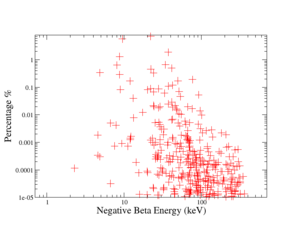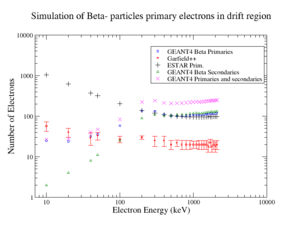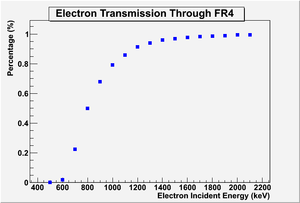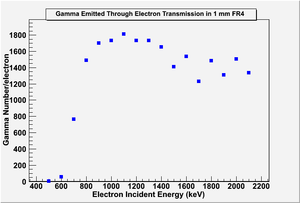Difference between revisions of "Beta Transmission and Ionization"
| (8 intermediate revisions by 2 users not shown) | |||
| Line 10: | Line 10: | ||
=Primary and secondary ionization= | =Primary and secondary ionization= | ||
| − | A simulation for Beta ionization was performed by using GEANT4. GEANT4 simulated the interaction of a beta particle in the drift region that contained 90/10 Ar/CO2 gas; the simulation estimated the ionization primary and secondary electrons. Figure XX illustrates that the number of primary electrons is inversely proportional to the incident beta particle energy; such a relationship agrees with Bethe-Bloch equation for estimating the energy loss. The figure also shows | + | A simulation for Beta ionization was performed by using GEANT4. GEANT4 simulated the interaction of a beta particle in the drift region that contained 90/10 Ar/CO2 gas; the simulation estimated the ionization primary and secondary electrons. Figure XX illustrates that the number of primary electrons is inversely proportional to the incident beta particle energy; such a relationship agrees with Bethe-Bloch equation for estimating the energy loss. The figure also shows GEANT4 underestimation for the number of primaries when for beta particle of energy of 10 keV, and when the energy is higher than 300 keV; one of the reasons that GEANT4 does not consider the minimum ionization for an ion-electron for Ar/CO2 or miscalculate it, or the electron cut is still high that makes it hard to track the low energy electrons. On the other hand, Garfield simulation for the number of electrons in the drift region when a beta particle passes through, and agreed with Bethe-Bloch formula, so the highest number of primaries is for low energy betas.Additionally, the number of primaries decreases gradually as beta energy increases to reach to the minimum ionization for Ar/CO2 gas which is in average 24 eV. |
[[File: G4_1cmAr90CO2_Beta_primaryElecN.png| 300 px]][http://articles.adsabs.harvard.edu/cgi-bin/nph-iarticle_query?bibcode=1967ApJS...14..207L&db_key=AST&page_ind=0&plate_select=NO&data_type=GIF&type=SCREEN_GIF&classic=YES] | [[File: G4_1cmAr90CO2_Beta_primaryElecN.png| 300 px]][http://articles.adsabs.harvard.edu/cgi-bin/nph-iarticle_query?bibcode=1967ApJS...14..207L&db_key=AST&page_ind=0&plate_select=NO&data_type=GIF&type=SCREEN_GIF&classic=YES] | ||
| + | |||
| + | |||
| + | Leo: 1 e-ion pair per 30 eV of energy loss , a 100 keV electron loosing all of its energy to ionization produces 3333 e-ion pairs | ||
| + | |||
| + | Sauli: a 100 keV electron causes 1000 e-ion pairs per cm and 3000 secondary e-ion pairs. | ||
| + | |||
| + | What is GEANT4 cut that produces 1000 primary ionization. | ||
| + | |||
| + | ;The range cut on line 111 in the GEANT4 file Em10PhysicsList.cc is set to 0.03 mm to prevent the tracking electrons whose mean free path is less than 0.03 mm. GEANT4 predicts 10^3 primary ionization events for a 100 keV electron traversing a 90/10 mixture of ArCo2 followed by 3 \times 10^2 secondary ionization events. | ||
| + | |||
| + | Why is Garfield only getting 30 | ||
| + | |||
| + | Why is e-star only getting 200 | ||
| + | |||
| + | G4 cut is in Em10PhysicsList.cc, line 111, and it is a length cut, to have 10^3 primaries and 3x10^3 secondaries, range cut = 0.03 mm . which means to track to zero electrons of range of 0.03 mm. | ||
= Beta Ionization with FR4 shutter= | = Beta Ionization with FR4 shutter= | ||
| Line 31: | Line 46: | ||
[[ HAM_Beta_extras]] | [[ HAM_Beta_extras]] | ||
| + | |||
| + | |||
| + | GO BACK [https://wiki.iac.isu.edu/index.php/Performance_of_THGEM_as_a_Neutron_Detector#Simulation_and_Analysis] | ||
Latest revision as of 23:06, 21 April 2015
GEANT4 simulated Beta particles in the drift region with a 90/10 Ar/CO2 gas. U-233 emits Beta particles with a range extends up to 600 keV, Although Beta particles are low in rates as compared to Alpha rates; they contribute in the detector total charge. GEANT4 is used for simulating the charge for a Beta particle that passed through the drift region, and estimated the primary and secondary electrons for each Beta particle energy. Additionally, GEANT4 helps studying the penetration of beta particles through 1mm FR4 shutter.
Beta particles energy rates
Beta particles are emitted from U-233 radioactive isotope, their energy spectrum vs the percentage of the emitted Beta is shown in figure XX. Based on the figure, the rates are lower than 0.1 percent, with only two specific energies reach up to 6 percent for 10 keV for one of the energies, and 30 keV for the other.
Primary and secondary ionization
A simulation for Beta ionization was performed by using GEANT4. GEANT4 simulated the interaction of a beta particle in the drift region that contained 90/10 Ar/CO2 gas; the simulation estimated the ionization primary and secondary electrons. Figure XX illustrates that the number of primary electrons is inversely proportional to the incident beta particle energy; such a relationship agrees with Bethe-Bloch equation for estimating the energy loss. The figure also shows GEANT4 underestimation for the number of primaries when for beta particle of energy of 10 keV, and when the energy is higher than 300 keV; one of the reasons that GEANT4 does not consider the minimum ionization for an ion-electron for Ar/CO2 or miscalculate it, or the electron cut is still high that makes it hard to track the low energy electrons. On the other hand, Garfield simulation for the number of electrons in the drift region when a beta particle passes through, and agreed with Bethe-Bloch formula, so the highest number of primaries is for low energy betas.Additionally, the number of primaries decreases gradually as beta energy increases to reach to the minimum ionization for Ar/CO2 gas which is in average 24 eV.
Leo: 1 e-ion pair per 30 eV of energy loss , a 100 keV electron loosing all of its energy to ionization produces 3333 e-ion pairs
Sauli: a 100 keV electron causes 1000 e-ion pairs per cm and 3000 secondary e-ion pairs.
What is GEANT4 cut that produces 1000 primary ionization.
- The range cut on line 111 in the GEANT4 file Em10PhysicsList.cc is set to 0.03 mm to prevent the tracking electrons whose mean free path is less than 0.03 mm. GEANT4 predicts 10^3 primary ionization events for a 100 keV electron traversing a 90/10 mixture of ArCo2 followed by 3 \times 10^2 secondary ionization events.
Why is Garfield only getting 30
Why is e-star only getting 200
G4 cut is in Em10PhysicsList.cc, line 111, and it is a length cut, to have 10^3 primaries and 3x10^3 secondaries, range cut = 0.03 mm . which means to track to zero electrons of range of 0.03 mm.
Beta Ionization with FR4 shutter
The FR4 shutter stops the low energy betas from U-233, and passes the high energy ones to ionize the gas in the drift region. U-233 beta emission relative rate is as low as 0.1 for most beta energies, and discussed previously, the highest beta rates are for those of kinetic energy of 10 keV and 30 keV. GEANT4 simulation shows in figure yy that 80 percent of Beta particles of energy of 1 MeV penetrate the shutter, and close to 100 percent penetration for beta energies which are equal or larger than 1.3 MeV. However, those low energy betas have the major contribution to the total number of primary and secondary electrons in the drift region; therefore, when the shutter is closed, only beta particles with energy more than 400keV contribute to the number of primary and secondary electrons. Those Betas have a negligible effect on the detector total charge due to the their low emission rates and the amount of charge they create in the drift region.
Combined Gamma
Electron multiple scattering causes Gamma particles to appear through beta transmission in the FR4. Electron scattering is one of the interactions of beta particles with FR4, photons are produced through this process depending on beta's energy.
It is noticed from the figure above that the maximum scattering cross section is for 1100 keV beta particles, the number of photons reaches to 1800 for each beta particle that transport through 1cm of FR4.
GO BACK [2]



